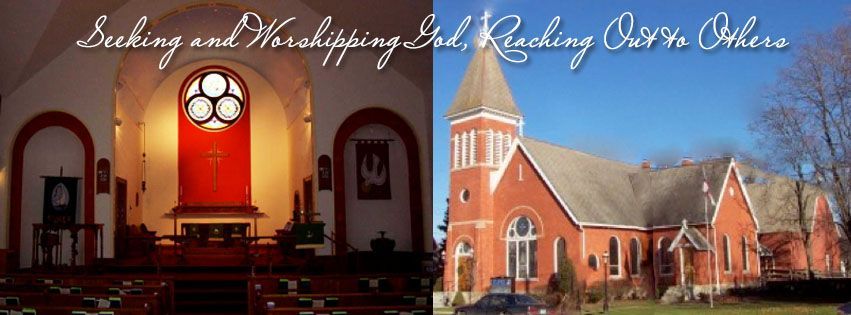
St. Jude’s Episcopal Church was formally organized on July 18, 1859 by the Ladies’ Mite Society of Fenton, Michigan. The following year a simple frame building was constructed on the present site of the church, which was deeded to the parish by William Adelaide of Fenton.
In 1893, ground was broken for a new and larger church, which was designed in the Romanesque Revival style by Pratt and Koeppe of Bay City. On July 28, 1893 the cornerstone of St. Jude’s was laid by Rev. Thomas Macheau, acting for the Bishop of Michigan. The new church had been erected at a cost of $6,500. The history books tell us that, after the laying of the cornerstone, “an elaborate dinner was served by St. Jude’s Guild at the Fireman’s Hall for 25 cents a plate.” The new church was open for services on March 11, 1894 and was consecrated by the Bishop in April 1894.
Before the new church was erected, meetings were held in various homes, over downtown stores, in churches of other denominations, or in the local Roberts House hotel. In 1859, St Jude’s Church of Fenton was incorporated, and services were conducted by clergyman who were on their way to various other towns that were also in need of their ministry.
The first time the choir sang was on Sunday, May 26, 1895, under the direction of Miss Flora Davis. The choir consisted of 4 men and 14 boys. It was not until Miss Davis left that women and girls were allowed to sing in the choir.
The ivy that grows on the north side of the church was brought to St Jude’s from a cathedral in England by Rev. Reasoner during his time here as rector. The ivy is a nice bond between St Jude’s and the Church of England.
In 1922 it was decided by the vestry that St Jude’s was not financially able to have a rectory and that we would have to operate the church under a non-resident because of poor economic times.
The vestry was increased from 7 members to 12 in 1924. The pledges that year totaled $2,334, and it was decided to purchase a rectory. It was agreed that, on a 50/50 basis, with the parish and the diocese each paying, we purchased the property on W. Shiawassee Ave., for $6,000. The new rector, Rev. L.P. Haggar, now had a rectory to live in. In August 1938, he was called to be the Archdeacon of the Diocese.
Also in 1938, more classrooms were needed for Sunday School, as well as activity areas, so the basement of the church was remodeled adding classrooms, a small kitchenette and lavatories.
In 1953, there was an expansion drive and the rectory on W. Shiawassee Ave., was exchanged for property on E. Elizabeth St., adjacent to the church. It was to be used as a Parish House, office space and church school. In 1958, the house just south of the church on S. Leroy St. was purchased for a rectory and 2 houses and land on Oak St., south of the Parish House, were purchased. This area later became the parking lot. The rectory on S. Leroy St. was first occupied by Rev. David Covell and his family.
In the early 1960’s, the Parish House had become too small for our needs, more plans were made to construct a new Parish House.
VandenBergh Hall was added in 1966 and has been in constant use since it opened for parish activities and community meetings. It was dedicated by Bishop Emrich on Oct. 9, 1966.
A library was created from a former choir room in 1973 and is located outside the nave door and is a quiet and convenient location for study or committee meetings.
The mortgage was burned at the 10:30 service on June 13, 1976. In about 1978, it was decided by the vestry that we no longer needed bear the expenses of owning a rectory, but rather gave the rector a housing allowance.
In 1979, the interior of the church was re-painted and the beams and altar, which had been painted white in 1951, were restored to their natural oak. The altar was moved forward from the wall, so that it was free-standing, allowing the priest to face the congregation in preparing for communion.
The property next to Vandenbergh Hall, which had earlier been reserved for a parking lot, was paved and lighted in 1985. A split rail fence was added later and a handicap ramp was also built.
St. Jude’s Episcopal Church building became a registered historical site in the 1990’s. At that time, extensive work was done to repair the artistically fashioned stained-glass windows and wood carvings. Funds were provided from a Capital Campaign.
St. Jude’s continued to grow with our next rector, Elizabeth Morris Downie’s coming in 1993. On Sept. 11, 1994, the Feast of the Holy Cross was celebrated during the dedication of the new cross. Shelves were installed along the bank under the new cross.
In 2005, we welcomed The Rev. Joshua Hoover and his family as our next rector.
In 2006, the plaster walls of the sanctuary were restored and painted in a beautiful historic fashion. The wooden pews and moldings were also rejuvenated as part of the same project. The choir stall and organ were moved to the front of the church, providing space for additional pews.
In April 2016, The Rev. Tracie L. Little was announced as our new full time Rector. She was with us for many years until she was called to the Diocese of Eastern Michigan to be their next Canon to the Ordinary in spring of 2022. We began a search for a new rector.
Our current Priest-in-Charge, The Rev. Susan Anslow-Williams has been serving our parish since August of 2023.
In 2024, a new handicap ramp was constructed and changes to the memorial garden are currently progressing to accommodate its new footprint.


